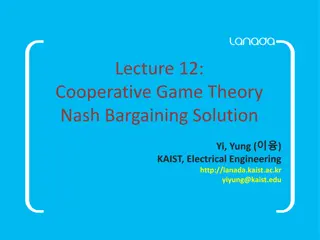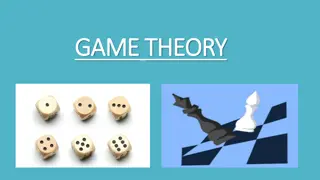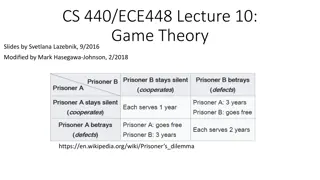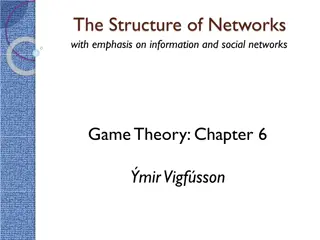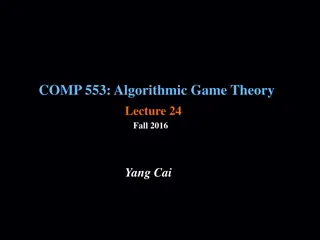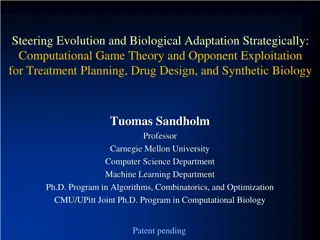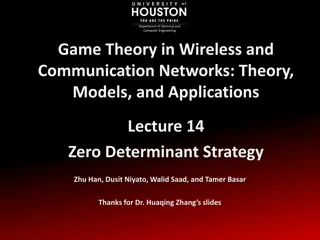Understanding Ultimatum Game in Game Theory
Ultimatum game is a fundamental model in game theory where two players engage in bargaining. Player 1 offers a share of money to Player 2, who can either accept or reject the offer. If accepted, Player 1 receives the remainder; otherwise, both get nothing. The formal model, extensive form representation, and backward induction solutions are discussed. Player strategies, optimal offers, and equilibrium outcomes are analyzed to understand the dynamics of the ultimatum game.
Download Presentation

Please find below an Image/Link to download the presentation.
The content on the website is provided AS IS for your information and personal use only. It may not be sold, licensed, or shared on other websites without obtaining consent from the author. Download presentation by click this link. If you encounter any issues during the download, it is possible that the publisher has removed the file from their server.
E N D
Presentation Transcript
EC941 - Game Theory Lecture 8 Prof. Francesco Squintani Email: f.squintani@warwick.ac.uk 1
Structure of the Lecture Ultimatum Game and Hold Up Problem Rubinstein Alternating Offer Bargaining Nash Axiomatic Bargaining 2
The Ultimatum Game The ultimatum game is a simple model of bargaining There are two players: person 1 offers player 2 an amount of money up to c. If 2 accepts this offer then 1 receives the remainder. If 2 rejects the offer then neither person receives any payoff. Each person cares only about the amount of money she receives, and prefers to receive as much as possible. The amount person 1 offers can be any number, not necessarily an integral number of cents. 3
Formal Model Players: The two people. Terminal histories: The set of sequences (x, Z), where x is a number with 0 x c (the amount of money that person 1 offers to person 2) and Z is either Y ( yes, I accept ) or N ( no, I reject ). Player function: P( ) = 1 and P(x) = 2 for all x. Preferences: Each person s preferences are represented by payoffs equal to the amounts of money she receives. For the terminal history (x, Y) person 1 receives c x and person 2 receives x; for the terminal history (x, N) each person receives 0. 4
Extensive Form Representation 1 Player 1 chooses first how much to give to player 2. Then player 2 chooses whether Yes or No. x = c x = 0 x 2 Y N c - x, x 0, 0 5
Backward Induction Solution First consider each subgame x where player 2 either accepts or rejects the offer x by player 1. For every x > 0, player 2 s optimal action is to accept (if she rejects, she gets nothing). For x = 0, person 2 is indifferent between accepting and rejecting. Thus in a subgame perfect equilibrium person 2 s strategy either accepts all offers x (including 0), or accepts all offers x > 0 and rejects the offer x = 0. 6
1 x = c x = 0 x Y N c, 0 0, 0 N Y 0, c 2 0, 0 Y N c - x, x 0, 0 7
Now consider the whole game. For each of the 2 possible subgame perfect equilibrium strategies of player 2, we find the optimal strategy of player 1. If player 2 accepts all offers x > 0, then player 1 s optimal offer is x = 0 (which yields her the payoff c). If player 2 accepts all offers x > 0, then there is nooffer x that is optimal for player 1. No offer x > 0 can be optimal, because x- is better for player 1, (as long as 0< <x). 8
The offer x = 0 is not optimal, as player 2 rejects it. The only subgame perfect equilibrium is the strategy pair where player 1 offers x = 0 and player 2 accepts all offers x > 0. In equilibrium, player 1 s payoff is c and player 2 s payoff is zero. 9
The holdup game Before an ultimatum game in which she may accept or reject an offer of person 1, person 2 may make an investment that changes the size of the pie. She may exert little effort, resulting in a small pie, of size cL, or great effort, resulting in a large pie, of size cH. Player 2 dislikes exerting effort: her payoff is x - E if her share of the pie is x, where E = L if she exerts little effort and E = H > L if she exerts great effort. 10
Extensive Form Representation 2 L H 1 1 x = cH x = 0 x = cL x = 0 x x 2 2 Y N Y N cH-x, x-H cL-x, x-L 0, -L 0, -H 11
Backward Induction Solution Each subgame that follows 2 s choice E is an ultimatum game. It has a unique subgame perfect equilibrium, in which 1 offers x = 0 and 2 accepts all offers x > 0. Consider 2 s choice of effort at the start of the game. If she chooses L then her payoff is -L . If she chooses H then her payoff is H. 12
So, player 1 chooses L at the beginning of the game. Thus the game has a unique subgame perfect equilibrium. In the SPE, player 2 exerts little effort and player 1 obtains all of the resulting small pie. 13
Two Period Alternating Offers Two players bargain over a pie of size 1. In period 1, player 1 makes a split proposal (x, 1-x). If player 2 accepts the proposal, it is implemented. Else, in period 2, player 2 makes proposes (y, 1-y). If player 1 accepts the proposal, it is implemented. Each player i discounts time at rate i. 14
Subgame Perfect Equilibrium The subgame starting after player 2 rejects a proposal (x, 1-x) of player 1 is an ultimatum game. It has a unique subgame perfect equilibrium: player 2 proposes (0, 1) and player 1 accepts all proposals. This yields payoffs of 0 for player 1 and 2 for player 2. So, in the subgame after a proposal (x, 1-x) of player 1, if player 2 rejects the proposal, her payoff is 2. 15
So, player 2 rejects any proposal (x, 1-x) with 1-x < 2 and accepts if 1 x > 2. Hence, player 1 initially proposes (1- 2, 2). In fact, if proposing any x > 1 2, player 1 anticipates that player 2 will reject proposal (x, 1-x), so that player 1 s eventual payoff will be zero. Intuitively, if player 2 is more impatient (i.e., 2 is smaller), then she gets a lower payoff in the bargain. 16
Rubinstein Bargaining Model Consider the following model in which players may alternate offers indefinitely. Players. The two negotiators: 1 and 2. Terminal histories. Every sequence of the form (x0, N, x1, N, ..., xt, Y) with t > 0, and every (infinite) sequence of the form (x0, N, x1, N, ...). To each xr corresponds a split proposal (xr, 1- xr). N stands for rejection and Y for acceptance. 17
Player Function. P() = 1, P(x0, N, x1, N, ..., xt) = P(x0, N, x1, N, ..., xt, N) = 2 if t is odd, P(x0, N, x1, N, ..., xt) = P(x0, N, x1, N, ..., xt, N) = 1 if t is even. Preferences. The players payoffs at any terminal history (x0, N, x1, N, ..., xt, Y) are t1 xt and t2 (1-xt), and zero at the infinite terminal history (x0, N, x1, N, ...). 18
Subgame Perfect Equilibrium All subgames starting at odd periods are isomorphic, and so are all subgames starting at even periods. So, we can introduce these stationary bounds: xiH is the largest equilibrium share of player 1 in a subgame where player i makes the initial proposal. xiL is the smallest equilibrium share of player 1 in a subgame where player i makes the initial proposal. 19
In a SPE, player 1 rejects all proposals with a payoff lower than her minimal payoff in her next round. Hence, we obtain that in any SPE, x2L > 1x1L. The smallest share of player 1 when 2 makes a proposal is no smaller than the discounted smallest share of player 1, when player 1 makes a proposal. Interchanging players, in any SPE, 1-x1H > 2(1-x2H). 20
Player 2 does not make any proposals with a payoff lower than her minimal payoff in her next round. I.e., player 2 never proposes a share of player 1 larger than player 1 s maximal payoff in the next round. Hence, we obtain that in any SPE, x2H < 1x1H. Again, interchanging players, we obtain that in any SPE, 1-x1L < 2(1-x2L). 21
Substitution yields: 1 - x1H > 2(1 - 1x1H), 1 - x1L < 2(1 - 1x1L) x2L > 1[1 - 2 (1 - x2L)], x2H > 1[1 - 2 (1 - x2H)] Further rearranging yields: 1 - 2 1(1 - 2) x1L > > x1H and x2L > > x2H 1 - 1 2 1 - 1 2 So, the unique outcome is x = 1 - 2 1 - 1 2 Player 1 s payoff increases in 1 and decreases in 2. 22
Nash Axiomatic Bargaining The bargaining models seen so far are positive : they find solutions of realistic bargaining models. A normative approach to study bargaining is to find solutions that satisfy ethically reasonable requirements. For example, if two identical players bargain over a good, we reasonably require that each gets half. This embodies two principles: Efficiency and Fairness. 23
But what if the players preferences are not identical? Denote by X the set of possible agreements, and by D the failure to agree. Let uibe player i s utility over X {D}, with di = ui(D). Define expected utilities Eui over X {D}, as usual. Define the payoff set U ={(v1, v2) : vi = Eui(L), for some lottery L over X {D}}. 24
Definition A bargaining problem is a pair (U, d) such that d is a member of U, U is convex, bounded, and closed, for some (v1, v2) in U we have v1 > d1 and v2 > d2. Definition A bargaining solution is a function from the set of bargaining problems (U, d) to U. A basic assumption of the model is that the solution depends only on the preferences on lotteries over X {D}, not on the specific payoff functions ui. 25
We introduce the following requirements (axioms). 1 Invariance to equivalent utility representations. Let (U, d) be a bargaining problem, let ai and bi be numbers with ai > 0 for i = 1, 2. Let U ={(a1v1+b1, a2v2+b2) : (v1, v2) is in U}, and let d = (a1d1+b1, a2d2+b2 ). If the solution of (U, d) is (v*1, v*2), then the solution of (U , d ) is (a1v*1+b1, a2v*2+b2) . 2 Symmetry. Let (U, d) be a bargaining problem for which (v1, v2) is in U if and only if (v2, v1) is in U, and d1= d2 . If the solution of (U, d) is (v*1, v*2), then v1*= v*2. 26
3 Pareto efficiency. Let (U, d) be a bargaining problem, and let (v1, v2) and (v 1, v 2) be members of U. If v1> v 1 and v2 > v 2, then (v 1, v 2) is not a bargaining solution of (U, d). 4 Independence of irrelevant alternatives. Let (U, d) and (U , d ) be bargaining problems for which U is a subset of U and d = d . If the solution v* of (U, d) is in U , then bargaining solution of (U , d ) coincides with v*. 27
Theorem (Nash bargaining solution) A unique bargaining solution satisfies the axioms INV, SYM, IIA, and PAR. This solution associates with the bargaining problem (U, d) the pair of payoffs that solves the problem: max (v1 - d1)(v2 - d2) (v1, v2) subject to (v1, v2) U and (v1, v2) > (d1, d2). The bargaining solution defined by the above Theorem is known as the Nash bargaining solution fN(U, d). 28
The proof or the Theorem is as follows. First note that because U is closed and bounded, the maximization problem defined has a solution. The solution is unique because the level curves of (v1 - d1)(v2 - d2) are strictly convex, and U is convex. Hence, the Nash bargaining solution fN is well defined. Now we check that fN satisfies the four axioms. 29
Define the function H by H(v1, v2) = (v1 - d1)(v2 - d2) for all (v1, v2). INV: Fix a1>0, a2 > 0, b1 and b2. Let U be the set of all pairs (a1v1+b1, a2v2+b2) where (v1, v2) is in U, and let d =(a1d1+b1, a2d2+b2) . Then for every pair (v1 , v2 ) in U there is a pair (v1, v2) in U with vi =aivi+bi for i = 1, 2. Thus the maximizer of (v1 - d1 )(v2 - d2 ) over U is (a1v1*+b1, a2v2*+b2), where (v1*, v2*) is the maximizer of (a1v1+b1 - d1 )(a2v2+b2 - d2 ) over U. 30
But (a1v1+b1 - d1)(a2v2+b2 - d2) = a1a2H(v1, v2), so (v1*, v2*), equals fN(U, d), the Nash solution of (U, d). SYM: If (U, d) is symmetric, the symmetry of the level curves of (v1 - d1)(v2 - d2) implies that f1N(U, d) = f2N(U, d). PAR: The function H is increasing in each of its arguments, so v does not maximize H(v) over U if there exists v U with v1 > vi for i = 1, 2. IIA: If U is a subset of U and v* U maximizes H(v) over U, then v* also maximizes H(v) over U . 31
Finally, I argue that if f is a bargaining solution that satisfies the four axioms, then f = fN. Let (U, d) be an arbitrary problem. I need to show that f(U, d) = fN(U, d). Step 1. Let fN(U, d) = z. Because there exists v U such that vi > di for i = 1, 2, we have zi > di for i = 1, 2. So, let ai=1/[2(zi - di)] and bi= -di /[2(zi- di)], for i=1, 2. 32
Define U = {(v1, v2)|vi = aivi + bi for i =1, 2} and d =(a1d1+b1, a2v2+b2 ). Note that d =(0, 0) and that aizi+bi = 1/2, for i=1, 2. Because the Nash solution satisfies INV, fN(U , d ) = (a1z1+b1 , a2z2+b2 ) = (1/2, 1/2). By INV, f(U, d) = z if and only if f(U ,d ) = (a1z1+b1 , a2z2+b2 ). Thus it suffices to show that f(U ,d ) = (1/2, 1/2). 33
Step 2. I claim that U contains no point (v1, v2) for which v1 +v2 > 1. Suppose to the contrary that it does, and let (t1 , t2 ) = (1/2 (1 ) + v1 , 1/2 (1 ) + v2 ), for 0 < < 1. The set U is convex, so (t1 , t2 ) is in U for all . But for small enough values of we have t1 t2 > 1/4 , contradicting fN(U , 0) = (1/2, 1/2). 34
Step 3. The set Uis bounded, so the result of Step 2 ensures that we can find a rectangle T that is symmetric about the 45 line, that contains U , and on the boundary of which is (1/2, 1/2). Step 4. By PAR and SYM we have f (T, 0) = (1/2, 1/2). Step 5. By IIA we have f (U , 0) = f (T, 0), so that f (U , 0) = (1/2, 1/2), completing the proof. 35
This result is a very deep one within the axiomatic normative approach to social sciences. The approach and the result can be described as follows, in the words of John Nash: One states as axioms several properties that it would seem natural for the solution to have and then one discovers that the axioms actually determine the solution uniquely. (Nash,1953, pp. 129.) 36
Summary of the Lecture Ultimatum Game and Hold Up Problem Rubinstein Alternating Offer Bargaining Nash Axiomatic Bargaining 37
THE END! Thank you. 38





